Mexican Cartel Tactical Note #30: Marijuana Kettlebells and Catapult and Air Cannon Projectiles
Robert J. Bunker and Marisa Mendoza
Key Information: “Drug catapult discovered on Mexico border.” NBC News. 26 January 2011,
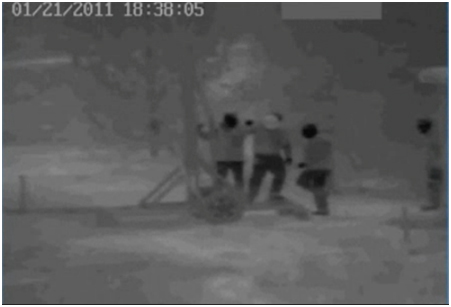
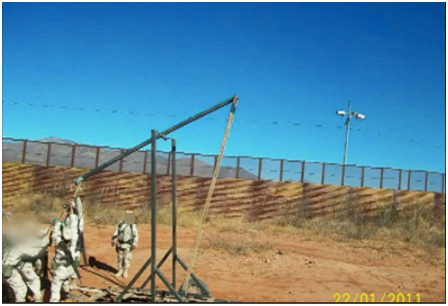
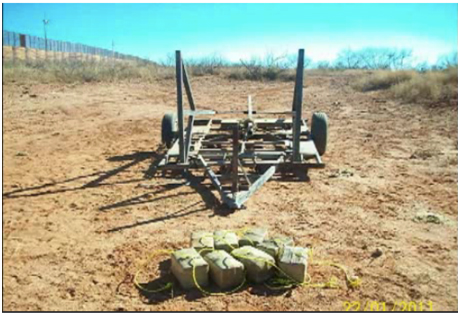
NACO, Ariz. — Drug smugglers used a catapult to fire contraband over the border between Mexico and Arizona, authorities said Wednesday.
National Guard troops operating a remote video surveillance system on Friday evening saw several people using the device beside a border fence near the town of Naco, and Border Patrol agents contacted Mexican authorities, NBC station KVOA of Tucson reported, citing U.S. Customs and Border Protection.
Mexican authorities disrupted the operation, but the alleged smugglers fled the scene in a Humvee, leaving the catapult behind — along with 45 pounds of marijuana and an SUV.
Night-vision video taken by the National Guard and supplied by KVOA shows several men preparing the catapult and launching packages before fleeing.
Still images taken at the scene shows soldiers testing the catapult, which was powered with elastic and was brought in mounted on a trailer. It’s not clear from the video whether they are Mexican or U.S. troops.
“I have not seen anything like that in my time before as a Border Patrol agent ... although we are trained to handle any kind of a threat that comes over that border,” Tucson sector Border Patrol spokesman David Jimarez told Reuters.
U.S. authorities said the dismantling of the operation was an example of close cooperation between American and Mexican agencies.
Naco is in Cochise County, about 80 miles southeast of Tucson…
Key Information: “El Centro Sector Border Patrol Intercepts Drugs Thrown Over Border Fence.” U.S. Customs and Border Protection. 11 January 2012, https://www.cbp.gov/newsroom/local-media-release/el-centro-sector-border-patrol-intercepts-drugs-thrown-over-border-0:
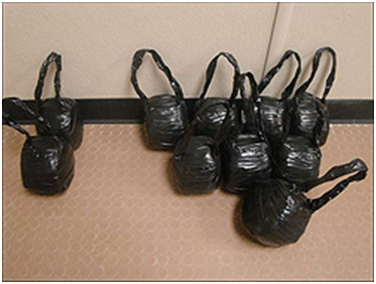
CALEXICO, CALIF.—On Monday, El Centro Sector Border Patrol agents assigned to the Calexico station arrested three suspects attempting to smuggle illegal narcotics.
The incident occurred around 5:45 a.m., after Border Patrol agents conducting surveillance near Downtown Calexico observed several suspicious packages being thrown over the U.S.-Mexico border fence. Agents then observed two individuals, a 19-year-old female and 23-year-old male, gather the packages and loaded them into a nearby vehicle.
Agents responding to the incident subsequently pulled over the vehicle and discovered multiple kettlebell-like packages of suspected narcotics inside. The driver of the vehicle, a 22-year-old female, was placed under arrest along with the other two suspects. All three individuals were identified as U.S. citizens.
In total, 10 packages of marijuana weighing approximately 13 pounds were seized. The street value of the illegal narcotics is estimated at more than $10,000. The drugs were turned over to the Imperial Valley Narcotics Task Force along with the vehicle and suspects involved in the incident…
Key Information: “Marijuana launch: Cannon used to shoot 85 pounds of pot into US, Border Patrol says.” CBS News. 12 December 2012, http://www.cbsnews.com/news/marijuana-launch-cannon-used-to-shoot-85-pounds-of-pot-into-us-border-patrol-says/:
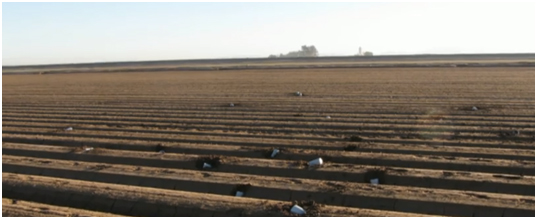

(CBS/AP) YUMA, Ariz. - U.S. Border Patrol agents said 33 cans of marijuana were spotted Friday in what they believe was a creative way to smuggle drugs in the country by shooting them out of a cannon.
Authorities said the cans were discovered in a field near where the Colorado River crosses the U.S.-Mexico border. They believe the cans were launched about 500 feet into the U.S. using a pneumatic-powered cannon.
After searching the area, agents recovered a carbon dioxide tank.
Authorities said Border Patrol agents in the Yuma sector near the Arizona-California border are adapting and shifting resources as smugglers come up with new ways of transporting their contraband.
The 85 pounds of marijuana found in the cans had an estimated value of $42,500.
Mexican authorities were also notified and searched their side of the border.
Key Information: Attila Nagy, “13 Shockingly Creative Ways Drugs Have Crossed the Border.” Gizmodo. 19 March 2013, http://gizmodo.com/5988877/13-shockingly-creative-ways-drugs-have-crossed-the-border:

This improvised cannon was confiscated in Mexicali, Mexico, on Feb. 26 of this year Police in the border city say the cannon was used to hurl packets of marijuana across a border fence into California. The truck-mounted device is made of PVC piping attached to an air compressor and driven by an automobile engine. It could launch up to 13kg of drugs at a time.
Key Information: Timothy Clemons, “Marijuana balls thrown over border fence.” News 4 Tucson. 18 July (1 August) 2015, http://www.kvoa.com/story/29578473/marijuana-balls-thrown-over-border-fence:
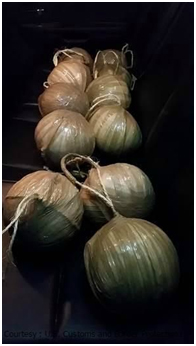
DOUGLAS, AZ - On July 12th U.S. Customs and Border Protections were able to seize marijuana balls smugglers had thrown over the border fence in Douglas, AZ.
Around 11:30 p.m. Douglas Station Tactical Operations Center saw balls of narcotics being thrown over the border fence on a camera near Agua Prieta, Mexico. A bike patrol was sent to the location and found twelve balls of marijuana weighing 26.4 pounds…
Key Information: Christopher Woody, “Mexican police found a ‘homemade bazooka’ that might have been used to fling drugs across the border.” Business Insider. 18 September 2016, http://www.businessinsider.com/mexican-narco-drug-cannon-discovered-across-border-from-arizona-2016-9:
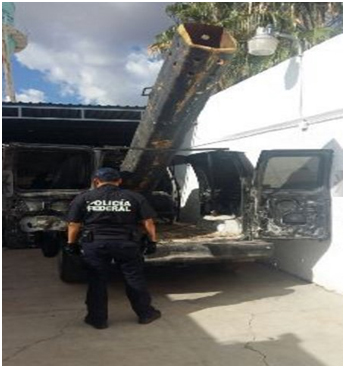
Earlier this week, Mexican federal police in Sonora came across a panel van with modifications and additions that allowed it carry a “cannon” possibly used to launch drugs over the border into the US.
According to a release from the federal police, officers came across the van while it was parked in northwest Sonora state’s Agua Prieta municipality, which borders Arizona and New Mexico. The van was found without license plates and its doors were open.
Inside the vehicle, authorities found “an air compressor, a gasoline motor, a tank for storing air and a metallic tube of approximately 3 meters in length (homemade bazooka).”
The “unit,” as the release referred to it, also had a cut in the end that could have allowed the metal tube to be hooked up to launch projectiles, possibly across the border.
The vehicle in question was linked to a car theft in Hermosillo, Sonora, according to an investigation dated July 1 this year.
Days before, authorities in the same area reportedly found a vehicle with similar additions…
Key Information: Geneva Sands and Jack Date, “How Smugglers Attempt to Get Drugs and Other Contraband Over the Border.” ABC News. 21 September 2016, http://abcnews.go.com/US/smugglers-attempt-drugs-contraband-border/story?id=42218894:
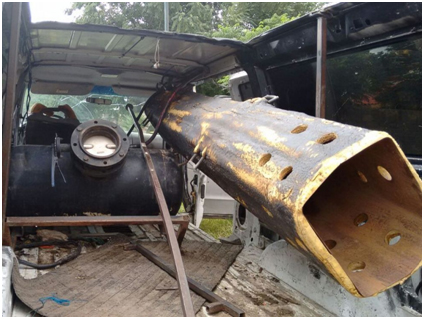
Mexican authorities said on Monday that they had discovered a homemade bazooka that appeared to be designed to launch packages over the border fence from Mexico into the United States.
This makeshift launcher, discovered in the state of Sonora across from Arizona, is the latest in innovative methods used to smuggle drugs and other contraband over the International Boundary Fence into the U.S.
While the bazooka method has been used to throw drugs over a fenced area of the border in the past, it is not common or particularly effective, according to Customs and Border Protection (CBP). A similar contraption was discovered on the California border in 2013.
“As you might guess, someone needs to be reasonably close to the fence to receive the package of drugs where agents patrol. Or come by later to look for it,” CBP spokesperson Ralph DeSio said in a statement to ABC News…
…Another method is to construct a trebuchet, which is similar to a catapult but uses a hinged counterweight or stored energy source instead of a flexible arm. Trebuchets and air cannons are generally seized by authorities in Mexico, said CBP Joint Task Force-West’s John Lawson.
…The most common method is by lobbing softball-sized packages of marijuana over the fence, according to CBP. Several “balls” are thrown into a U.S. residential area, such as a backyard, and are retrieved by a co-conspirator, Lawson said.
Smugglers have also constructed cannons that use high-pressure air to launch marijuana over the fence and into an open field, according to CBP. These projectiles can weigh up to 60 pounds…
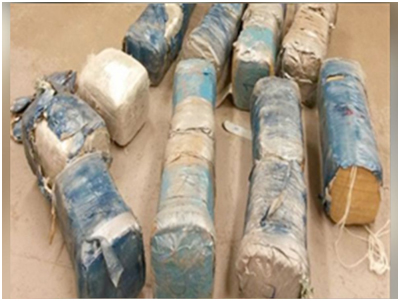
Key Information: Christopher Woody, “US border agents found another catapult flinging drugs over the US-Mexico border fence.” Business Insider. 15 February 2017, http://www.businessinsider.com/us-border-patrol-agents-find-narco-drug-catapult-on-border-wall-2017-2:
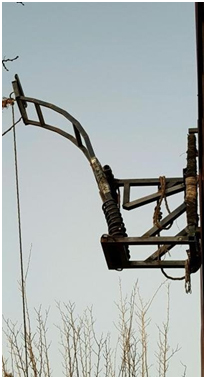
US border patrol agents at the Douglas, Arizona, port of entry southeast of Tucson encountered one of Mexican smugglers’ more low-tech methods for moving drugs over the border on Friday.
While on patrol east of the border crossing, US agents saw several people moving away from the border fence as they approached.
“When agents arrived at the fence they found a catapult system attached to the south side of the border fence,” Customs and Border Protection said in a release. “They searched the area and located two bundles of marijuana.”
CBP agents dismantled the catapult, which was seized by Mexican authorities.
It was used to launch at least two bundles of marijuana, weighing about 47 pounds, into the US. The drugs were seized by US authorities.
Despite their rarity in everyday life, catapults are not unheard of in the drug-smuggling world. Authorities on both sides of the border have encountered them on several occasions…
Who: Seizure locations and the dates they are taking place along the U.S.-Mexico border are consistent with the Sinaloa Cartel drug trafficking territories.
What: The smuggling of marijuana kettlebells/looped balls that are thrown over the border fence and marijuana projectiles that are either flung (by means of a trebuchet or catapult) or shot (by means of a compressed air cannon) over the border fence from Mexico into the United States.
When: The kettlebells/looped balls incidents date to January 2012 and July 2015; the trebuchet and catapult/projectile incidents date to January 2011 and February 2017, respectively; and the air cannon/projectile incidents date to December 2012, February 2013, and September 2016.
Where: The kettlebells/looped balls were found near El Centro, California and in Douglas, Arizona; the trebuchet and catapult/projectile incidents took place near Naco, Arizona and in Douglas, Arizona; and the air cannon/projectile incidents took place in the Yuma sector near the Arizona-California border, in Mexicali, Mexico (across from Calexico, California) and in the Agua Prieta municipality, Sonora, Mexico (across from Douglas, Arizona).
Why: As border checkpoint security increases, the Mexican cartels are continuously creating innovative means to successfully transport their drug loads into the U.S. Throwing or launching drug projectiles above the border fence represents an alternative over the border smuggling approach to such techniques as the use of drones (See Mexican Cartel Tactical Note # 21 and Mexican Cartel Strategic Note No. 18), vehicular ramps for SUVs/trucks (See Mexican Cartel Tactical Note # 29), and ultralight aircraft.
Analysis: All of these incidents focus on the tossing of marijuana packaged in kettlebells/looped balls and their flinging and firing as projectiles—such as square packages or tubular packages—from Mexico over the border into the United States. The weight of the human thrown packages are about 13 pounds while the catapult and cannon projected packages can range from about 2 ½ pounds for drug filled cans fired from small individually held carbon dioxide powered t-shirt-like launchers to 60 pounds for a heavy truck or van mounted air cannon which utilizes an air compressor, gasoline motor, and pressured air storage tank. The trebuchet and catapult systems identified launched bales of roughly 50 pounds of packaged marijuana—not too heavy for one man to load on the device and for another to pick up on the other side of the U.S. border and place in a transport vehicle. With only about 7 identifiable incidents spanning the January 2011 through February 2017 time frame, however, this over the border smuggling technique is both sporadic in use and marginal in impact with narcotics valued measured in the hundreds of thousands of dollars at best—though quite a few more incidents of kettlebells/looped balls thrown over the border wall have had to have taken place due to simplicity of this smuggling technique. Recovered marijuana loads had estimated valuations ranging from just over $11,000.00 (for the kettlebells) to roughly $210,000.00 (for the multiple 60 pounds tubes). Given the low economic values of this trafficking technique, it fully represents a minor sideshow to Sinaloa cartel trafficking activities and may possibly be conducted by semi-independent drug smuggling gangs with the tacit approval of Sinaloa cartel gatekeepers—once, of course, the requisite tax is paid to that cartel to engage in such activities. This assumption is reflected by the fact that only marijuana is being trafficked utilizing this technique rather than heroin, cocaine, or methamphetamine that have far greater values and profit margins ounce-for-ounce than bulk marijuana smuggling.
Significance: Catapults, Drug Trafficking, Innovative Technology Use, Over the Border Smuggling, Projectiles, Sinaloa Cartel, U.S.-Mexico Border Fence
References
“Marijuana launch: Cannon used to shoot 85 pounds of pot into US, Border Patrol says.” CBS News. 12 December 2012, http://www.cbsnews.com/news/marijuana-launch-cannon-used-to-shoot-85-pounds-of-pot-into-us-border-patrol-says/.
Timothy Clemons, “Marijuana balls thrown over border fence.” News 4 Tucson. 18 July (1 August) 2015, http://www.kvoa.com/story/29578473/marijuana-balls-thrown-over-border-fence.
Attila Nagy, “13 Shockingly Creative Ways Drugs Have Crossed the Border.” Gizmodo. 19 March 2013, http://gizmodo.com/5988877/13-shockingly-creative-ways-drugs-have-crossed-the-border.
“Drug catapult discovered on Mexico border.” NBC News. 26 January 2011,
Geneva Sands and Jack Date, “How Smugglers Attempt to Get Drugs and Other Contraband Over the Border.” ABC News. 21 September 2016, http://abcnews.go.com/US/smugglers-attempt-drugs-contraband-border/story?id=42218894.
“El Centro Sector Border Patrol Intercepts Drugs Thrown Over Border Fence.” U.S. Customs and Border Protection. 11 January 2012, https://www.cbp.gov/newsroom/local-media-release/el-centro-sector-border-patrol-intercepts-drugs-thrown-over-border-0.
Christopher Woody, “Mexican police found a ‘homemade bazooka’ that might have been used to fling drugs across the border.” Business Insider. 18 September 2016, http://www.businessinsider.com/mexican-narco-drug-cannon-discovered-across-border-from-arizona-2016-9.
Christopher Woody, “US border agents found another catapult flinging drugs over the US-Mexico border fence.” Business Insider. 15 February 2017, http://www.businessinsider.com/us-border-patrol-agents-find-narco-drug-catapult-on-border-wall-2017-2.

